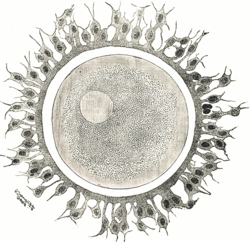Zygote
| Zygote (cell) | |
|---|---|
 |
|
| Details | |
| Days | 0 |
| Precursor | Gametes |
| Gives rise to | Morula |
| Identifiers | |
| Code | TE E2.0.1.2.0.0.9 |
|
Anatomical terminology
[]
|
|
A zygote (from Greek ζυγωτός zygōtos "joined" or "yoked", from ζυγοῦν zygoun "to join" or "to yoke"), is a eukaryotic cell formed by a fertilization event between two gametes. The zygote's genome is a combination of the DNA in each gamete, and contains all of the genetic information necessary to form a new individual. In multicellular organisms, the zygote is the earliest developmental stage. In single-celled organisms, the zygote can divide asexually by mitosis to produce identical offspring.
Oscar Hertwig and Richard Hertwig made some of the first discoveries on animal zygote formation.
In fungi, the sexual fusion of haploid cells is called karyogamy. The result of karyogamy is a diploid cell called a zygote or zygospore. This cell may then enter meiosis or mitosis depending on the life cycle of the species.
In plants, the zygote may be polyploid if fertilization occurs between meiotically unreduced gametes.
In land plants, the zygote is formed within a chamber called the archegonium. In seedless plants, the archegonium is usually flask-shaped, with a long hollow neck through which the sperm cell enters. As the zygote divides and grows, it does so inside the archegonium.
In human fertilization, a release ovum (a haploid secondary oocyte with replicate chromosome copies) and a haploid sperm cell (male gamete)—combine to form a single 2n diploid cell called the zygote. Once the single sperm enters the oocyte, it completes the division of the second meiosis forming a haploid daughter with only 23 chromosomes, almost all of the cytoplasm, and the sperm in its own pronucleus. The other product of meiosis is the second polar body with only chromosomes but no ability to replicate or survive. In the fertilized daughter, DNA is then replicated in the two separate pronuclei derived from the sperm and ovum, making the zygote's chromosome number temporarily 4n diploid. After approximately 30 hours from the time of fertilization, fusion of the pronuclei and immediate mitotic division produce two 2n diploid daughter cells called blastomeres.
...
Wikipedia
